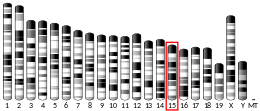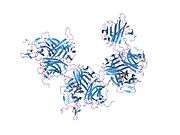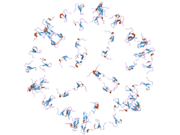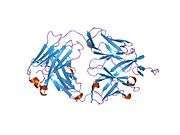BAFF receptor
BAFF receptor (B-cell activating factor receptor, BAFF-R), also known as tumor necrosis factor receptor superfamily member 13C (TNFRSF13C) and BLyS receptor 3 (BR3), is a membrane protein of the TNF receptor superfamily which recognizes BAFF, an essential factor for B cell maturation and survival.[5][6] In humans it is encoded by the TNFRSF13C gene.[7]
| TNFRSF13C | |||||||||||||||||||||||||
|---|---|---|---|---|---|---|---|---|---|---|---|---|---|---|---|---|---|---|---|---|---|---|---|---|---|
 | |||||||||||||||||||||||||
| |||||||||||||||||||||||||
| Identifiers | |||||||||||||||||||||||||
| Aliases | TNFRSF13C, BAFF-R, BAFFR, BROMIX, CD268, CVID4, prolixin, tumor necrosis factor receptor superfamily member 13C, TNF receptor superfamily member 13C | ||||||||||||||||||||||||
| External IDs | OMIM: 606269 MGI: 1919299 HomoloGene: 49897 GeneCards: TNFRSF13C | ||||||||||||||||||||||||
| |||||||||||||||||||||||||
| |||||||||||||||||||||||||
| Orthologs | |||||||||||||||||||||||||
| Species | Human | Mouse | |||||||||||||||||||||||
| Entrez | |||||||||||||||||||||||||
| Ensembl | |||||||||||||||||||||||||
| UniProt | |||||||||||||||||||||||||
| RefSeq (mRNA) | |||||||||||||||||||||||||
| RefSeq (protein) | |||||||||||||||||||||||||
| Location (UCSC) | Chr 22: 41.92 – 41.93 Mb | Chr 15: 82.22 – 82.22 Mb | |||||||||||||||||||||||
| PubMed search | [3] | [4] | |||||||||||||||||||||||
| Wikidata | |||||||||||||||||||||||||
| |||||||||||||||||||||||||
Function
B-cell activating factor (BAFF) enhances B-cell survival in vitro and is a regulator of the peripheral B-cell population. The protein encoded by this gene is a receptor for BAFF and is a type III transmembrane protein containing a single extracellular phenylalanine-rich domain. It is thought that this receptor is the principal receptor required for BAFF-mediated mature B-cell survival.[7] In B cell maturation, due to regulation by BAFF-R, only a limited amount of B-cell will survive.[8]
Clinical significance
Overexpression of BAFF in mice results in mature B-cell hyperplasia and symptoms of systemic lupus erythematosus (SLE). Also, some SLE patients have increased levels of BAFF in serum. Therefore, it has been proposed that abnormally high levels of BAFF may contribute to the pathogenesis of autoimmune diseases by enhancing the survival of autoreactive B cells, which are cells that show immune response to normal body cells.[7] Autoreactive B cells are less sensitive toward BAFF and are usually outcompeted by the normal B cells in the maturation process regulated by low BAFF-R expression. An elevated level of BAFF-R can therefore overcome this decreased response and result in accumulation of autoreactive B cells.[8]
BAFF and BAFF-R pair can also down-regulate the cell apoptosis process.[9]
References
- GRCh38: Ensembl release 89: ENSG00000159958 - Ensembl, May 2017
- GRCm38: Ensembl release 89: ENSMUSG00000068105 - Ensembl, May 2017
- "Human PubMed Reference:". National Center for Biotechnology Information, U.S. National Library of Medicine.
- "Mouse PubMed Reference:". National Center for Biotechnology Information, U.S. National Library of Medicine.
- Thompson JS, Bixler SA, Qian F, Vora K, Scott ML, Cachero TG, Hession C, Schneider P, Sizing ID, Mullen C, Strauch K, Zafari M, Benjamin CD, Tschopp J, Browning JL, Ambrose C (September 2001). "BAFF-R, a newly identified TNF receptor that specifically interacts with BAFF". Science. 293 (5537): 2108–11. doi:10.1126/science.1061965. PMID 11509692.
- Yan M, Brady JR, Chan B, Lee WP, Hsu B, Harless S, Cancro M, Grewal IS, Dixit VM (October 2001). "Identification of a novel receptor for B lymphocyte stimulator that is mutated in a mouse strain with severe B cell deficiency". Current Biology. 11 (19): 1547–52. doi:10.1016/S0960-9822(01)00481-X. PMID 11591325.
- "Entrez Gene: TNFRSF13C tumor necrosis factor receptor superfamily, member 13C".
- Brink R (October 2006). "Regulation of B cell self-tolerance by BAFF". Seminars in Immunology. 18 (5): 276–83. doi:10.1016/j.smim.2006.04.003. PMID 16916609.
- Rauch M, Tussiwand R, Bosco N, Rolink AG (2009-05-06). "Crucial role for BAFF-BAFF-R signaling in the survival and maintenance of mature B cells". PLOS ONE. 4 (5): e5456. doi:10.1371/journal.pone.0005456. PMC 2673681. PMID 19421318.
External links
- Human TNFRSF13C genome location and TNFRSF13C gene details page in the UCSC Genome Browser.
Further reading
- Laâbi Y, Egle A, Strasser A (December 2001). "TNF cytokine family: more BAFF-ling complexities". Current Biology. 11 (24): R1013-6. doi:10.1016/S0960-9822(01)00613-3. PMID 11747837.
- Defrance T, Casamayor-Pallejà M, Krammer PH (2003). The life and death of a B cell. Advances in Cancer Research. 86. pp. 195–225. doi:10.1016/S0065-230X(02)86006-7. ISBN 9780120066865. PMID 12374279.
- Ambrose CM (2003). "BAFF-R". Journal of Biological Regulators and Homeostatic Agents. 16 (3): 211–3. PMID 12456020.
- Bossen C, Schneider P (October 2006). "BAFF, APRIL and their receptors: structure, function and signaling" (PDF). Seminars in Immunology. 18 (5): 263–75. doi:10.1016/j.smim.2006.04.006. PMID 16914324.
- Treml LS, Crowley JE, Cancro MP (October 2006). "BLyS receptor signatures resolve homeostatically independent compartments among naïve and antigen-experienced B cells". Seminars in Immunology. 18 (5): 297–304. doi:10.1016/j.smim.2006.07.001. PMID 16919470.
- Kalled SL (October 2006). "Impact of the BAFF/BR3 axis on B cell survival, germinal center maintenance and antibody production". Seminars in Immunology. 18 (5): 290–6. doi:10.1016/j.smim.2006.06.002. PMID 16931038.
- Mackay F, Leung H (October 2006). "The role of the BAFF/APRIL system on T cell function". Seminars in Immunology. 18 (5): 284–9. doi:10.1016/j.smim.2006.04.005. PMID 16931039.
- Schneider P, MacKay F, Steiner V, Hofmann K, Bodmer JL, Holler N, Ambrose C, Lawton P, Bixler S, Acha-Orbea H, Valmori D, Romero P, Werner-Favre C, Zubler RH, Browning JL, Tschopp J (June 1999). "BAFF, a novel ligand of the tumor necrosis factor family, stimulates B cell growth". The Journal of Experimental Medicine. 189 (11): 1747–56. doi:10.1084/jem.189.11.1747. PMC 2193079. PMID 10359578.
- Hartley JL, Temple GF, Brasch MA (November 2000). "DNA cloning using in vitro site-specific recombination". Genome Research. 10 (11): 1788–95. doi:10.1101/gr.143000. PMC 310948. PMID 11076863.
- Yan M, Brady JR, Chan B, Lee WP, Hsu B, Harless S, Cancro M, Grewal IS, Dixit VM (October 2001). "Identification of a novel receptor for B lymphocyte stimulator that is mutated in a mouse strain with severe B cell deficiency". Current Biology. 11 (19): 1547–52. doi:10.1016/S0960-9822(01)00481-X. PMID 11591325.
- Rolink AG, Melchers F (April 2002). "BAFFled B cells survive and thrive: roles of BAFF in B-cell development". Current Opinion in Immunology. 14 (2): 266–75. doi:10.1016/S0952-7915(02)00332-1. PMID 11869903.
- Xu LG, Shu HB (December 2002). "TNFR-associated factor-3 is associated with BAFF-R and negatively regulates BAFF-R-mediated NF-kappa B activation and IL-10 production". Journal of Immunology. 169 (12): 6883–9. doi:10.4049/jimmunol.169.12.6883. PMID 12471121.
- Kim HM, Yu KS, Lee ME, Shin DR, Kim YS, Paik SG, Yoo OJ, Lee H, Lee JO (May 2003). "Crystal structure of the BAFF-BAFF-R complex and its implications for receptor activation". Nature Structural Biology. 10 (5): 342–8. doi:10.1038/nsb925. PMID 12715002.
- Liu Y, Hong X, Kappler J, Jiang L, Zhang R, Xu L, Pan CH, Martin WE, Murphy RC, Shu HB, Dai S, Zhang G (May 2003). "Ligand-receptor binding revealed by the TNF family member TALL-1". Nature. 423 (6935): 49–56. doi:10.1038/nature01543. PMID 12721620.
- Gordon NC, Pan B, Hymowitz SG, Yin J, Kelley RF, Cochran AG, Yan M, Dixit VM, Fairbrother WJ, Starovasnik MA (May 2003). "BAFF/BLyS receptor 3 comprises a minimal TNF receptor-like module that encodes a highly focused ligand-binding site". Biochemistry. 42 (20): 5977–83. doi:10.1021/bi034017g. PMID 12755599.
This article incorporates text from the United States National Library of Medicine, which is in the public domain.







